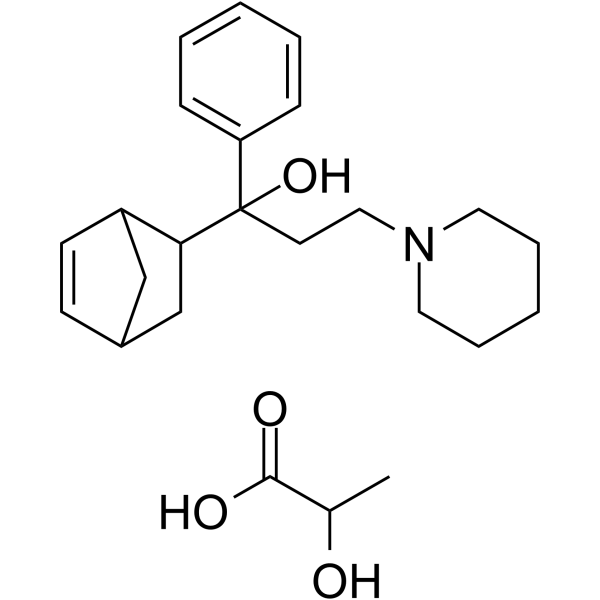biperiden lactate
Modify Date: 2025-08-25 20:15:54

biperiden lactate structure
|
Common Name | biperiden lactate | ||
|---|---|---|---|---|
| CAS Number | 7085-45-2 | Molecular Weight | 401.53900 | |
| Density | N/A | Boiling Point | 462.1ºC at 760mmHg | |
| Molecular Formula | C24H35NO4 | Melting Point | N/A | |
| MSDS | N/A | Flash Point | 224.5ºC | |
Use of biperiden lactateBiperiden (KL 373) lactate is an orally active non-selective muscarinic receptor antagonist that competitively binds to M1 muscarinic receptors. Biperiden (KL 373) lactate inhibits acetylcholine and enhances dopamine signaling in the central nervous system. Biperiden (KL 373) lactate has the potential for the research of Parkinson's disease and other related psychiatric disorders[1][2]. |
| Name | 1-(5-bicyclo[2.2.1]hept-2-enyl)-1-phenyl-3-piperidin-1-ylpropan-1-ol,2-hydroxypropanoic acid |
|---|
| Description | Biperiden (KL 373) lactate is an orally active non-selective muscarinic receptor antagonist that competitively binds to M1 muscarinic receptors. Biperiden (KL 373) lactate inhibits acetylcholine and enhances dopamine signaling in the central nervous system. Biperiden (KL 373) lactate has the potential for the research of Parkinson's disease and other related psychiatric disorders[1][2]. |
|---|---|
| Related Catalog | |
| In Vitro | Biperiden lactate (29.6 μg/ml, 72 hours) can significantly induce apoptosis and inhibit proliferation at high doses in human pancreatic ductal adenocarcinoma cells[1]. Cell Proliferation Assay[1] Cell Line: Panc-1, Panc-2 and BxPC3 human pancreatic ductal adenocarcinoma cells Concentration: 29.6 μg/mL Incubation Time: 72 hours Result: Inhibited cell proliferation at 72 hours significantly by reducing nuclear c-Rel translocation. |
| In Vivo | Biperiden lactate (intraperitoneal injection, 10 mg/kg, everyday, 3 weeks) reduces tumor size by 83% in subcutaneous xenograft mouse using Panc-1 human pancreatic ductal adenocarcinoma cells[1]. Biperiden lactate (intraperitoneal injection, 8 mg/kg, every 8 hours, 10 days) can reduce frequency of spontaneous seizures and extracellular hippocampal glutamate levels while cause a long-term decrease in hippocampal excitability[2]. Animal Model: Subcutaneous xenograft mouse using Panc-1 human pancreatic ductal adenocarcinoma cells[1] Dosage: 10 mg/kg Administration: Intraperitoneal injection; everyday; 3 weeks Result: Tumor size reduced by 83%. Animal Model: Male Wistar rats (200-250 g)[2] Dosage: 8 mg/kg Administration: Intraperitoneal injection; every 8 hours; 10 days Result: Reduced late seizures by about three times with no affecting emotional memory damage |
| References |
| Boiling Point | 462.1ºC at 760mmHg |
|---|---|
| Molecular Formula | C24H35NO4 |
| Molecular Weight | 401.53900 |
| Flash Point | 224.5ºC |
| Exact Mass | 401.25700 |
| PSA | 81.00000 |
| LogP | 3.35210 |
CHEMICAL IDENTIFICATION
HEALTH HAZARD DATAACUTE TOXICITY DATA
|